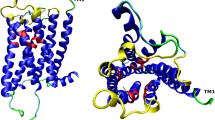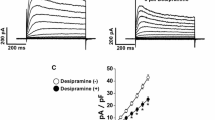Summary
To determine the muscarinic receptor subtype involved in the contractile response of coronary smooth muscle, we investigated the profiles of various muscarinic receptor antagonists competing for [3H]N-methyl-scopolamine ([3H]NMS) binding to membrane preparations from porcine coronary arteries. [3H]NMS binds to a single population of muscarinic binding sites with a KD of 135 pM and a Bmax of 57 fmol/mg. The affinity profiles of AF-DX 116 [11-2((−((diethylamino)methyl)-1-piperidinyl)acetyl)-5,11-dihydro-6H-pyrido(2,3-b)(1,4)-benzodiazepin-6-one], atropine, 4-DAMP [4-diphenylacetoxy-N-methylpiperidine methiodide], methoctramine [N,N′-bis (6-((2-methoxybenzyl) amino)hexyl)-1,8-octane-diamine tetrahydrochloride], HHSiD [hexahydrosiladi-fenidol] and pirenzepine are consistent with binding to a mixed population of muscarinic binding sites, namely of the M2 and M3 subtype.
Binding curves for AF-DX 116 and methoctramine are shallow with Hill-coefficients significantly less than unity. Comparison of data from binding studies with results obtained in functional experiments, i.e. antagonism of methacholine induced contraction of porcine coronary artery rings, it was found that only the low-affinity pKi values of AF-DX 116 (6.26) and methoctramine (6.51) correlated well with functional pA2 values.
It is concluded that a mixed population of the M2 and M3 muscarinic receptor subtypes is present in porcine coronary arteries. Functional experiments do not support the contribution of the M2 subtype to the contractile response. Cholinergic induced contractions of porcine coronary arteries appear to be evoked via stimulation of the muscarinic M3 receptor subtype. However, since the compounds investigated here do not markedly discriminate between cloned m3, m4 and m5 receptors the involvement of muscarinic receptors different from M1, M2 and M3 cannot be excluded.
Similar content being viewed by others
References
Arunlakshana AD, Schild HO (1959) Some quantitative uses of drug antagonists. Br J Pharmacol 14:48–58
Barlow RB, Berry KJ, Glenton PAM, Nikolaou NM, Soh KS (1976) A comparison of affinity constants for muscarine-sensitive acetylcholine receptors in guinea-pig atrial pacemaker cells at 29°C and in ileum at 37°C. Br J Pharmacol 58:613–620
Batink HD, Davidesko D, Doods HN, Van Charldorp KJ, De Jonge A, Van Zwieten PA (1987) Subdivision of M2 receptors into theee subtypes. Br J Pharmacol 90:81 P
Buckley NJ, Bonner TI, Buckley CM, Brann MR (1989) Antagonist binding properties of five cloned muscarinic receptors expressed in CHO-K1 cells. Mol Pharmacol 35:469–476
Cheng YC, Prusoff WH (1973) Relationship between the inhibition constant (Ki) and the concentration of inhibitor which causes 50 per cent inhibition (IC50) of an enzymatic reaction. Biochem Pharmacol 22:3099–3108
Delmendo RE, Michel AD, Whiting RL (1989) Affinity of muscarinic receptor antagonists for three putative muscarinic receptor binding sites. Br J Pharmacol 96:457–464
Dodds WJ (1982) The pig model for biomedical research. Fed Proc 41:247–256
Doods HN, Mathy MJ, Davidesko D, Van Charldorp KJ, De Jonge A, Van Zwieten PA (1987) Selectivity of muscarinic antagonists in radioligand and in vivo experiments for the putative M1, M2 and M3 receptors. J Pharmacol Exp Ther 242:257–262
Duckles SP (1988) Vascular muscarinic receptors: Pharmacological characterization in the bovine coronary artery. J Pharmacol Exp Ther 246:929–934
Eglen RM, Whiting RL (1986) Muscarinic receptor subtypes: A critique of the current classification and a proposal for a working nomenclature. J Anton Pharmacol 5:323–346
Endo M, Hirosawa K, Kaneko N, Hase K, Inoue Y, Konno S (1976) Prinzmetal's variant angina. Coronary arteriogram and left ventriculogram during angina attack induced by methacholine. N Engl J Med 294:252–255
Ganz P, Ludmer PL, Alexander RW, Shook TL, Wayne R, Mudge GH, Selwyn AP (1986) Impaired endothelium-dependent coronary dilation in patients with coronary artery disease. Blood Vessels 23:70
Giachetti A, Micheletti R, Montagna E (1986) Cardioselective profile of AF-DX 116, a muscarine M2 receptor antagonist. Life Sci 38:1663–1672
Hammer R, Berrie CP, Birdsall NJM, Burgen ASV, Hulme EC (1980) Pirenzepine distinguishes between different subclasses of muscarinic receptors. Nature (Lond) 283:90–92
Hammer R, Giraldo A, Schiavi GB, Monferine E, Ladinsky H (1986) Binding profile of a novel cardioselective muscarine antagonist, AF-DX 116, to membranes of peripheral tissues and brain in the rat. Life Sci 387:1653–1662
Heinzel G (1982) Topfit. In: Bozler G, Van Rossum JM (eds) Pharmacokinetics during drug development: Data analysis and evaluation techniques. Gustav Springer, Stuttgart, p 207
Kugiyama K, Jasue H, Horio Y, Morikami Y, Fujii H, Kimura T (1986) Possible role of parasympathic nervous system in the pathogenesis of exercise-induced coronary artery spasm. Am Heart J 112:605–606
Lowry OH, Rosebrough NJ, Farr AL, Randall RJ (1951) Protein measurement with the Folin phenol reagent. J Biol Chem 193:265–275
Melchiorre C, Angeli P, Lambrecht G, Mutschler E, Picchio MT, Wess J (1987) Antimuscarinic action of methoctramine, a new cardioselective M-2 muscarinic receptor antagonist, alone and in combination with atropine and gallamine. Eur J Pharmacol 144:117–124
Micheletti R, Montagna E, Giachetti A (1987) AF-DX 116, a cardioselective muscarinic antagonist. J Pharmacol Exp Ther 142:628–634
Mutschler E, Lambrecht G (1984) Selective muscarinic agonists and antagonists in functional tests. Trends Pharmacol Sci 5 (Supplement Subtypes of Muscarinic Receptors) I:39–44
Rinner I, Doods FIN, Van Charldorp KJ, Davidesko D, Van Zwieten PA (1988) Binding of muscarine receptor antagonists to pig coronary smooth muscle. Naunyn-Schmiedeberg's Arch Pharmacol 337:146–150
Tallarida RJ, Jacobs LS (1979) The dose-response relation in pharmacology. Springer, Berlin Heidelberg New York
Van Charldorp KJ (1988) Characterization of muscarinic receptors in the vascular system. PhD Thesis, University of Amsterdam
Van Charldorp KJ, Batink HD, Mol F (1989) Comparison of muscarinic binding sites in porcine coronary artery and ileum. Naunyn-Schmiedeberg's Arch Pharmacol 339 (Supplement): 328
Van Charldorp KJ, Van Zwieten PA (1989) Comparison of the muscarinic receptors in the coronary artery, cerebral artery and atrium of the pig. Naunyn-Schmiedeberg's Arch Pharmacol 339:403–408
Yamada S, Yamazawa T, Harada Y, Yamamura HI, Nakayama K (1988) Muscarinic receptor subtype in porcine coronary artery. Eur J Pharmacol 150:373–376
Yasue H, Horio Y, Nakamura N, Fujii H, Sonoda R, Kugiyama K Obata K, Morikami Y, Kumura T (1986) Induction of coronary artery spasm by acetylcholine in patient with variant angina. Possible role of the parasympathic nervous system in the pathogenesis of coronary artery spasm. Circulation 74:955–963
Author information
Authors and Affiliations
Additional information
Send offprint requests to M. Entzeroth at the above address
Rights and permissions
About this article
Cite this article
Entzeroth, M., Doods, H.N. & Mayer, N. Characterization of porcine coronary muscarinic receptors. Naunyn-Schmiedeberg's Arch Pharmacol 341, 432–438 (1990). https://doi.org/10.1007/BF00176336
Received:
Accepted:
Issue Date:
DOI: https://doi.org/10.1007/BF00176336




